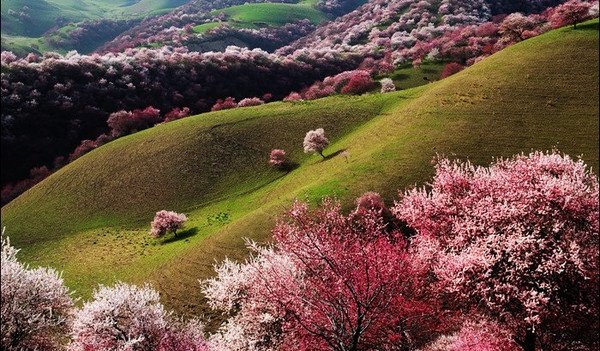Spring is upon us, arguably the most beautiful season of them all, where the world awakens after a long, quiet and cold winter. Whilst China may be known for its ancient temples, winding Great Wall, Terracotta Army, and towering architecture, it’s possible to forget about the many beautiful parks, crystalline lakes, and expansive green countryside that stretch across the country.
These natural spaces all truly come to life during the springtime as the cherry blossoms begin to flourish, the wildlife becomes a buzz of activity, and the country turns into a vibrant land of flowers. There are plenty of beautiful places to wander to across China during the spring months, but here are some of the most stunning spots to witness the country in full bloom.
Pudacuo National Park, Yunnan

Located in Shangri-La County in the north of Yunnan Province, Pudacuo National Park offers breathtaking scenic views, surrounded by towering mountains, evergreen forests, and sprawling lakes. Spanning nearly 1,300 kilometres-squared of land, the park offers a diverse range of flowers, fauna, and wildlife.

The province of Yunnan is well-known for being especially awe-inspiring and as a region of biodiversity, sometimes even referred to as China’s ‘Spring City’. Notable for being the first national park in the whole of China to meet International Union for Conservation of Nature standards, Pudacuo National Park includes the Bita Lake Nature Reserve and the Duhu Scenic Area in the Hongshan Region, both of which sites are part of the Three Parallel Rivers of Yunnan Protected Areas World Heritage Site.
Incredibly, more than 20% of China’s plant species and nearly one-third of the country’s mammal and bird species can be found across the wetland park, letting visitors truly soak in the country’s diverse natural life. Particular highlights include the numerous different types of rare orchid, the Himalayan Yew trees, the highly endangered black-necked cranes, and the Bita double-lip fish found in the park’s Bita Lake. The fish are a renowned ancient species, thought to be swimming through the Earth’s waters for more than 2.5 million years, dating back to the Fourth Glacial Age.
Beijing Botanical Garden, Beijing
In the northwest outskirts of China’s capital, Beijing, the Beijing Botanical Garden offers a tranquil sanctuary away from the bustling city. Housed between the Fragrant Hills Park (or Xiangshan Park) and Jade Spring Hill (Yuquan Hill), the garden covers 2 square-kilometres, consisting of the Plant Exhibition Area, the Scenic Spot and the Historical Resorts, the Scientific Research Area, and the Nature Reserve.

Flower and plant lovers can bask in the garden’s some 10,000 different categories of plant, with a carpet of more than 1.5 million plants growing throughout the land – in fact, the garden is considered to be the most eclectic natural space in the north of China.
Explore the garden’s natural beauty by gazing up at the rare trees, following the trail of colourful flowers, and wandering through the tropical greenhouses – the Greenhouse Exhibition Area holds the reputation of ‘the biggest display greenhouse in Asia’ and is an important site for scientific botany research. The Plant Exhibition Area includes a number of themed gardens, including the Lilac Garden, Chinese Rose Garden, Flowering Peach Garden, and Peony Garden, delivering magnificent photo opportunities.

The Botanical Garden is also home to a few historical attractions, including the Wofo Temple (or the Temple of Recumbent Buddha, one of the most famous ancient Buddhist temples in Beijing), Cao Xueqin Memorial (remembering author of Story of the Stone, often considered one of the Four Great Classical Novels of China) and Liang Qichao Tomb (commemorating the Chinese scholar, philosopher, journalist, and reformist from the late Qing Dynasty).
Beihai Park, Beijing

Another famed parkland in Beijing is the historical Beihai Park. First built in the 11th century, the park holds a rich history of Chinese royalty, spanning five dynasties: the Liao, the Jin, the Yuan, the Ming, and the Qing. Although it is no longer an imperial garden for the royal family, the park retains an exquisite and extravagant air, being one of the oldest, largest and best-preserved ancient gardens in the country.
Spanning 171 acres of land, half of which is covered in water by the Taiye Lake, Beihai Park is a grandiose site. One of the primary highlights is the Baita or White Pagoda that stands proud at the centre of Qinghau Island (Jade Flowery Islet), acting as a beacon for the whole park and a symbol of peace, where the remains of the Buddha’s body are laid. As well as the pagoda, the island houses the Yong’an Temple (Temple of Everlasting Peace), the Shanyin and Zhengjue Halls, a two-storey corridor showcasing views across the park, and other rockeries and pavilions.
Another area of the park worth venturing to is the Five-Dragon Pavilions, five connected pavilions that appear from a distance to look like a giant dragon snaking across the park. Standing on the north bank of the lake opposite the Qinghau Island, the pavilions encapsulate China’s traditional art, with splendid carvings and paintings among the walls.

The park holds a special magic all year round, but it is during the spring months when the flowers and trees blossom around the ancient buildings that Beihai Park looks at its best. It is beautiful by day as a garden of colour, and at night with the moonlight reflecting off of the lake.
Cherry Blossoms Festival, Yuyuantan
Capturing the romantic essence of cherry blossoms, Yuyuantan Park welcomes an annual Cherry Blossom Festival every spring, since its first in 1989. Although the park gets especially busy during the festival period, it is the perfect spot to take photographs. Filled with the delicate pink and white shades of the trees’ blossoms, the park invites thousands of tourists and locals to wander among the trees and around the lake. You can also take in the views by hopping on a dragon boat and riding along the lake.

Marvel at all of the different varieties of cherry blossom (more than 30 in total) among the some 2,400 cherry trees. Many of the trees hold a special history too; back in 1973, Japan presented a diplomatic gift to China to represent peaceful ties between the neighbouring countries. Visitors can also enjoy some cherry blossom themed snacks, such as cherry-blossom flavored ice-cream, cherry-blossom egg tarts, and preserved cherry blossoms.

Often considered the most beautiful mountain in China, Mount Huangshan (or ‘Mount Yellow’) in the Anhui Province offers charming scenic views across the country. It is renowned for its strangely shaped pines and rock formations, hot springs, and the mysterious clouds that hide its peaks, so called the ‘Four Wonders’. Altogether, the mountain range looks much like the inspiration for a great fantasy adventure novel or poetry collection (some authors have even cited the mountain as a source of creative insight).

The mountain was included in both the World Cultural and Natural Heritage lists back in 1990, lovingly recognised as a UNESCO site. Boasting more than 400 famous scenic attractions, 140 of which are open to tourists, Mount Huangshan becomes truly enchanting during the spring months.
As well as hiking up parts of the mountain (or taking a cable car if you’d prefer!), it’s worth visiting the surrounding ancient villages. The villages of Xidi in the Yixian County date back to a couple of centuries ago and are fantastically well preserved, providing a glimpse into the ancient customs and lifestyles that the village people still uphold.

Springtime is a period of wonder across China, with plenty of magical and captivating natural spaces to explore. Where will you visit?


